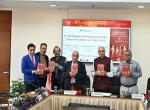The VIF held a Seminar on “Strategic Posture: Sino-Indian Border” on 3rd September 2012. Eminent speakers with practical experience on the subject made presentations on specific themes. While China’s Strategic Posture in Tibet, Infrastructure Development in Tibet, Ladakh and Arunachal Pradesh, PLA Air Forces Posture in Tibet were the themes discussed in Session I; Session II dealt with PLA’s Posture in Tibet, Situation in Ladakh/Aksai Chin and the Situation along the MacMohan Line.
In his inaugural address Gen. N.C. Vij (Retd.), former Chief of Army Staff, appropriated the context of the strategic scenario wherein China’s rise was a defining feature of the strategic landscape of the 21st Century. Its supremacy as a global power required it by nature, to establish its unchallenged supremacy in the immediate neighbourhood. India on its part has to respond to this challenge by virtue of its geography and rivaling competition, both in economically and militarily.
The Peoples Republic of China situates its rise and power from a strategy of “Self-Defence Counter-Attack”. This multipurpose formulation describes most instances where China has initiated the use of force, and effectively implies that that the PLA would launch a “first strike”. The 1962 War with India and border war with Russia fall in this category. There are various possibilities pertaining to India that follow from this strategy. First, possibility of an attack could arise within a near term of 3-5 years when Indian armed forces level of preparedness and readiness for is an issue under debate. Second, a long-term approach nearing 2020-2025 when the Chinese military modernization is expected to be completed on the one hand, and on the Indian side the capabilities gap would have increased exponentially.
Gen. Vij analysed the Chinese and India military capabilities and posed questions in scenarios of conflict so as to assess counter-capability strategies by India. He cautioned that some areas of excellence by the Chinese can only serve to increase the gaps over the years. These include;
- Prowess in asymmetric warfare, particularly in C41ISR that can empower commander to respond to complex battlefield conditions with agility and synchronization.
- Space and Counter-Space capabilities. The deployment of satellites enables real time transfer of data to ground stations as also multi-dimensional programs to limit, or deny, the use of space-based assets by adversaries.
- Cyber war capabilities - Intrusion and data theft is used to collect strategic intelligence and attempts to disrupt an enemy’s essential services like air, railways, banks etc. form part of developing this capability.
- Nuclear dimension- a continuation of developing their arsenal and blue water fleet. The stated “No first use” Chinese policy is not explicit and it therefore commits them to nothing.
Brig. Gurmeet Kanwal focused on China’s Strategic Posture in Tibet as his central theme in Session I. He observed that there was a steady improvement in India-China relations apart from the security relationship. And, while there is stability at the strategic level, China has been showing signs of political, diplomatic and military aggressiveness at the tactical level. There is an urgent need to resolve the territorial dispute by creatively working around the stated positions of both countries, failing which the security relationship would deteriorate further.

Lt. Gen. Gautam Banerjee (Retd.) presented a paper on Infrastructure Development in Tibet, Ladakh and Arunachal Pradesh. The central premise of infrastructure development precludes the questions, logistic infrastructure for what and that the development of logistics is military specific. He averred that at present, India has a deliberate go-slow policy and crucial to this would be the efficacious management of lead time. The essential doctrine should be of a Unified Logistic System which is in an integrated manner to be able to ‘sustain war’; it comprises mobile warfare that can be waged at the strategic and tactical levels, a purpose of power projection, adequate fire power and a modular system for RRFs. A joint logistics-support system is integrated to civilian infrastructure, comprises a multi-mode transportation element (land and air). There should be reserve logistic support units and depots and forward stocking.
Air Marshal K.K. Nohwar (Retd.) elaborated on the PLA Air Force Posture in Tibet. He gave out details of the PLAAF infrastructure in Tibet and their operational capabilities in Tibet. He also dwelt upon the missile sites and the type of exercises carried out by both PLAAF and missile forces.
In Session II of the Seminar commenced with Brig. Arun Sahgal’s (Retd.) analysis of the PLA’s Posture in Tibet. India’s strategic concerns regarding China arose from its emergence as the most influential actor in Asia with the ability to shape the future regional balance of power. Growing Chinese influence in India’s South Asian backyard and the extended Indian Ocean Region (IOR) were worrisome trends, where it believes Beijing to be severely depreciating its area of influence. China backs its aggressive assertions with a steady build up of comprehensive national power and military capability in the region. Its military budgets have annually grown in double digit figures over two decades, and the current 2012-13 Financial Year outlay crossing US $ 100 billion. Such enhanced military spending and concomitant growth in its military industrial complex continues to fuel apprehension of an assertive role in Asia and beyond. Among other things he also spoke on PLA’s force deployment opposite India.
The Situation in Ladakh/Aksai Chin was the subject of Lt. Gen. Vijay Ahluwalia’s (Retd) exposition in the larger Strategic Posture at the Sino-Indian Border theme. He provided a detailed analysis with the aid of topographical and illustrative maps of the precarious and delicate geographical realities in the Middle Sector and the Western Sector. The Line of Actual Control and demarcated boundaries in inhospitable terrain is a constant tug between the Indian and Chinese counterparts. The topographical boundary line is often based on perceptions and not actual calculations which results in constant flagging of territory. Infrastructure plays a big role in military strategy and posturing which the Chinese have harnessed to their advantage admirably. A national highway runs parallel to the LAC some kilometers away and in some areas are connected with tributary roads. The Indian reality and prowess is somewhat at a disadvantage on these scales. At present, there are several pockets of disputes over claimed areas like Chushul, Demohon etc which fray the Chinese and Indian relationship. There are three elements to the claims. i.) They could be mutually agreed disputed areas, ii.) Areas of differing LAC perception and, iii.) Emerging disputed areas.
Maj Gen. Dhruv Katoch (Retd.) made an analysis of the Situation along the MacMohan Line. The line extends from the Bhutan tri-junction to the border with Myanmar amounting to 1150 km in length with altitudes ranging from 13000-20000 ft. The terrain on the Indian side comprises five main valleys – Lohit, Dibang, Siang, Subansiri and Kameng. Independent operations take place along each valley through the existing communication links. The conflict between the two countries exists because the Line is not accepted by China and there are differences in interpretations, like the Wangdong incident illustrated. A further problem is created since the line is not demarcated and rather based on perceptions.
In the end Ambassador Kanwal Sibal made the special remarks and summed up the discussions during the course of the Seminar. It was widely attended by serving and retired officers from the defence establishment and ministry of external affairs, academicians and scholars.





